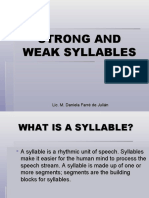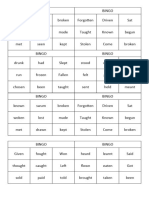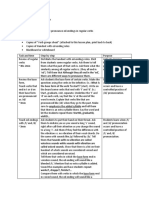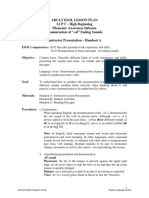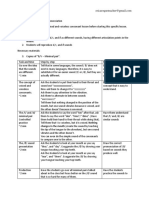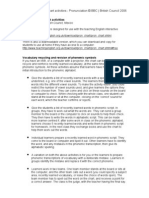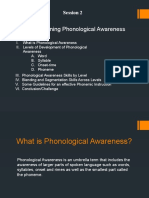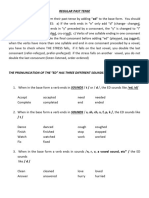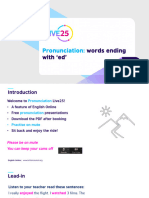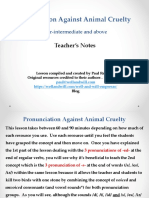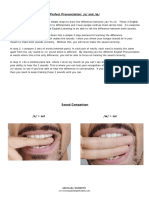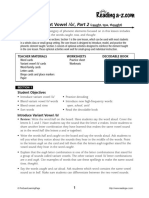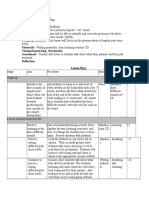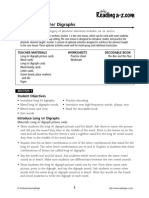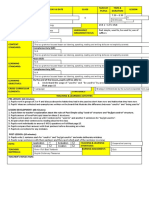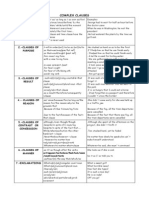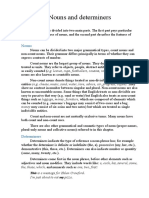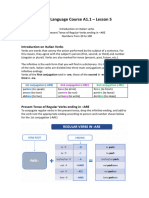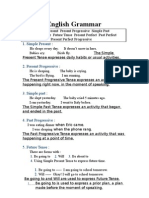0 ratings0% found this document useful (0 votes)
214 viewsEd Endings
Ed Endings
Uploaded by
api-476600295The lesson plan aims to teach students how to correctly pronounce regular verb endings. It includes reviewing rules for verbs ending in /t/, /d/ or /id/ and providing practice categorizing verbs according to their pronunciation. The plan has students work in pairs or groups to categorize verbs on a worksheet without assistance, to reinforce their learning of the pronunciation rules for regular verb endings.
Copyright:
© All Rights Reserved
Available Formats
Download as PDF, TXT or read online from Scribd
Ed Endings
Ed Endings
Uploaded by
api-4766002950 ratings0% found this document useful (0 votes)
214 views5 pagesThe lesson plan aims to teach students how to correctly pronounce regular verb endings. It includes reviewing rules for verbs ending in /t/, /d/ or /id/ and providing practice categorizing verbs according to their pronunciation. The plan has students work in pairs or groups to categorize verbs on a worksheet without assistance, to reinforce their learning of the pronunciation rules for regular verb endings.
Original Title
ed-endings
Copyright
© © All Rights Reserved
Available Formats
PDF, TXT or read online from Scribd
Share this document
Did you find this document useful?
Is this content inappropriate?
The lesson plan aims to teach students how to correctly pronounce regular verb endings. It includes reviewing rules for verbs ending in /t/, /d/ or /id/ and providing practice categorizing verbs according to their pronunciation. The plan has students work in pairs or groups to categorize verbs on a worksheet without assistance, to reinforce their learning of the pronunciation rules for regular verb endings.
Copyright:
© All Rights Reserved
Available Formats
Download as PDF, TXT or read online from Scribd
Download as pdf or txt
0 ratings0% found this document useful (0 votes)
214 views5 pagesEd Endings
Ed Endings
Uploaded by
api-476600295The lesson plan aims to teach students how to correctly pronounce regular verb endings. It includes reviewing rules for verbs ending in /t/, /d/ or /id/ and providing practice categorizing verbs according to their pronunciation. The plan has students work in pairs or groups to categorize verbs on a worksheet without assistance, to reinforce their learning of the pronunciation rules for regular verb endings.
Copyright:
© All Rights Reserved
Available Formats
Download as PDF, TXT or read online from Scribd
Download as pdf or txt
You are on page 1of 5
Lesson Plan ericaroqueteacher@gmail.
com
Pronunciation Project
Ed-endings – 10-minute lesson
Lesson Objectives:
• Students will correctly pronounce ed-endings in regular verbs.
Necessary materials:
• Copies of “Verb groups sheet” (attached to this lesson plan, print back to back)
• Copies of Handout with ed-ending rules
• Blackboard or whiteboard
Task and time Step-by-step Purpose
Review of regular Distribute the handout with ed-endings rules. Elicit Activate previous
verbs from students some regular verbs. Ask them to tell knowledge and quickly
~30s-2min them what the past of that verb is. Ask them what the prepare students for
similarity among all regular verbs is. (they all end in new information.
‘ed’.) Tell them that Although they all end in the ‘ed’,
there are different ways to pronounce them.
Review the base Ask students the base form of certain verbs. Make the Students learn when
form, questions using the verbs in the infinitive. Ex.: What is /id/ pronunciation
Teach verbs that the base form of the verb ‘to start’? (start). Write on occurs and have a
end in t or d on the board some verbs that end with ‘t’ and ‘d’. Ex.: controlled practice of
their base form Start, graduate, visit, separate. Underline the ‘t’ and /id/ pronunciation.
are pronounced ‘d’ on each verb, say that the ‘e’ at the end of the
as /id/ word is mute. Explain that verbs like that are
~3min pronounced like /id/ when they go to the past. Make
sure to emphasize the added syllable and tell them
that there is an extra syllable there. Say the word and
let the students repeat them: StartID, graduatID,
visitID…
Teach ed-endings Ask students to put their hand on their throat. Ask Students learn when /t/
with /t/ and /d/ them to imitate you as you sound a long ‘s’ sound, and /d/ pronunciation
~3min right after call their attention as you change the sound occurs and have a
to a long ‘z’. Ask them if they feel the difference with controlled practice of
the vibration vs. no vibration of their vocal chords. Do /t/ and /d/
the same with sounds like /p/ followed by /b/. Tell pronunciation.
them that Sounds with no vibration are called
voiceless sounds while sounds with vibration are
called voiced sounds. Show that there is a list on their
handout of which sounds are considered voiced and
which are considered unvoiced.
Tell them that verbs in which the base form end in
voiceless sound, the ed-ending will sound like a
blended /t/. Mention that no extra syllable is added.
Sound the examples and have students repeat:
workeT, droppeT, finisheT…
Lesson Plan ericaroqueteacher@gmail.com
Pronunciation Project
Compare them with verbs in which the base form end
in voiced sound, the ed-ending will sound like a
blended /d/. Mention that no extra syllable is added.
Sound the examples and have students repeat:
moveD, returneD, stayeD…
Practice Hand out the copies of “Verb groups sheet”. Assign Students practice all the
~4 min them into pairs or small groups, have them work in the knowledge in ed-
first exercise. Let them use their rules handout for this endings pronunciation.
practice. For each exercise there is 12 regular verbs to
be categorized into /t/, /d/, or /id/.
Production game Tell students to put away their rules handout. Make a Students complete the
~3 min for each small competition and see which team is able to exercise without help
exercise correctly categorize each verb in the group. from anything but their
group mates.
Lesson Plan ericaroqueteacher@gmail.com
Pronunciation Project
Past Tense Pronunciation for Regular Verbs (-ed)
Rule /id/: If the verb base Rule /t/: If the verb base Rule /d/: If the verb base
ends in a “t” or “d” sound ends in a voiceless sound, ends in a voiced sound,
already, then the –ed then the –ed ending then the –ed ending
ending sounds like “id”. sounds like “t”. sounds like “d”.
It is pronounced as an The “t” is blended The “d” is blended
extra syllable. together with the previous together with the previous
consonant. consonant.
A voiceless sound is like A voiced sound means
a whisper. Your vocal that your vocal chords
chords don’t vibrate. vibrate.
Voiceless consonant Voiced consonant
sounds: sounds:
p, f, k, s, sh, ch, th b, v, g, z, j, th, l, m, n, r
All vowel sounds are
voiced.
Examples of past tense Examples of past tense Examples of past tense
verbs where the –ed verbs where the –ed verbs where the –ed
ending sounds like “ed” ending sounds like “t” ending sounds like “d”
started worked moved
graduated dropped returned
visited finished stayed
separated divorced studied
dated stopped widowed
attended laughed raised
coughed engaged
watched traveled
Lesson Plan ericaroqueteacher@gmail.com
Pronunciation Project
Verb groups sheet
• Group 1
Needed Lived Shopped Chilled Picked Seated
Hated Dated Enjoyed Wished Crunched Tried
/t/ /d/ /id/
Lesson Plan ericaroqueteacher@gmail.com
Pronunciation Project
Verb groups sheet
• Group 2
Kissed Pulled Wanted Decided Played Snapped
Poured Laughed Visited Kicked Hugged Wasted
/t/ /d/ /id/
• Group 3
Robbed Tapped Added Ended Loved Baked
Begged Waited Danced Started Brushed Opened
/t/ /d/ /id/
You might also like
- Lesson Plan of Regular and Irregular Form of VerbDocument4 pagesLesson Plan of Regular and Irregular Form of Verbmezieldunlao1997No ratings yet
- Siop 2 - III Trimester Xi GradeDocument3 pagesSiop 2 - III Trimester Xi Gradeapi-296850820No ratings yet
- Interchange Intro Unit 16 Class PlanDocument3 pagesInterchange Intro Unit 16 Class PlanIsabela Mendes100% (1)
- Lesson Plan Pronunciation ProjectDocument5 pagesLesson Plan Pronunciation Projectapi-476600295No ratings yet
- Lesson Plan Pronunciation ProjectDocument5 pagesLesson Plan Pronunciation Projectapi-476600295No ratings yet
- 4BA0 01 Que 20200305Document20 pages4BA0 01 Que 20200305Rahat ShyedNo ratings yet
- Rancangan Pelajaran Tahunan Peralihan Bahasa InggerisDocument9 pagesRancangan Pelajaran Tahunan Peralihan Bahasa InggerisAisyah MsaidNo ratings yet
- English Phonetics and Phonology: A Practical CourseDocument4 pagesEnglish Phonetics and Phonology: A Practical CourseMilagros Hidalgo MadariagaNo ratings yet
- Ed Sounds Interactive Worksheet: Esl / Efl Resour CesDocument2 pagesEd Sounds Interactive Worksheet: Esl / Efl Resour CesleonNo ratings yet
- AssimilationDocument5 pagesAssimilationDo Son Hai (ARENA HN)No ratings yet
- Revision of ConsonantsDocument3 pagesRevision of ConsonantsTinBowNo ratings yet
- 102 - Task 2-Consonant Sounds - Mayra Angelica Correa OrdoñezDocument6 pages102 - Task 2-Consonant Sounds - Mayra Angelica Correa OrdoñezAngelica CorreaNo ratings yet
- Phonetics and Phonology - Task 6 - Written ExercisesDocument8 pagesPhonetics and Phonology - Task 6 - Written ExercisesDiana Marcela Garzon Plata100% (1)
- 8P - M. Luisa Garcia Lecumberri y John Maidment - English Transcription CourseDocument60 pages8P - M. Luisa Garcia Lecumberri y John Maidment - English Transcription CourseRosaliecoltNo ratings yet
- Test#1-2 Guillermo MendozaDocument5 pagesTest#1-2 Guillermo MendozaGuillermo MendozaNo ratings yet
- Strong and Weak SyllablesDocument22 pagesStrong and Weak SyllablesCarolina QuinteroNo ratings yet
- EstaireSh Zanon J. Chapter 1 - A Framework For Planning Units of WorkDocument16 pagesEstaireSh Zanon J. Chapter 1 - A Framework For Planning Units of WorkLauraNo ratings yet
- Silent Way Method FinalDocument8 pagesSilent Way Method Finalprecious deanonNo ratings yet
- Summary To Mark Tonicity, Tonality and ToneDocument13 pagesSummary To Mark Tonicity, Tonality and ToneAnonymous ljwrO9yFNo ratings yet
- Received Pronunciation ConsonantDocument6 pagesReceived Pronunciation ConsonantRain TolentinoNo ratings yet
- Phonetics and Phonology Assignment 1Document2 pagesPhonetics and Phonology Assignment 1A RmNo ratings yet
- Summary of How To Teach Pronunciation by Kelly, GeraldDocument25 pagesSummary of How To Teach Pronunciation by Kelly, GeraldMaria Ana Carnero0% (1)
- BINGO - Irregular Verbs Past ParticipleDocument2 pagesBINGO - Irregular Verbs Past ParticipleJaqueline CairesNo ratings yet
- Introduction To Pronunciation HandoutDocument49 pagesIntroduction To Pronunciation HandoutRheeva AnggaNo ratings yet
- Lesson Plan Pronunciation Project: There Are Different Ways To Pronounce ThemDocument5 pagesLesson Plan Pronunciation Project: There Are Different Ways To Pronounce Themapi-402677640No ratings yet
- Ed Sounds PDFDocument2 pagesEd Sounds PDFRahmi IhsaniahNo ratings yet
- Simple Past Regular U5Document10 pagesSimple Past Regular U5Keidegger Silva VillamizarNo ratings yet
- Compiled Learning MaterialDocument17 pagesCompiled Learning MaterialEllen Grace Baguilat PutacNo ratings yet
- Lesson-18 02Document3 pagesLesson-18 02gkjw897hr4No ratings yet
- Lesson Plan Pronunciation Project: Changes in The Mouth (Create The Sound by TouchingDocument3 pagesLesson Plan Pronunciation Project: Changes in The Mouth (Create The Sound by Touchingapi-476600295No ratings yet
- Phonics EFL Conference New GarethDocument41 pagesPhonics EFL Conference New GarethHaydee GonzalesNo ratings yet
- Pron Chart ActivitiesDocument4 pagesPron Chart ActivitiesLim Gim SiewNo ratings yet
- Lesson Plan Regular Verbs MarianaDocument4 pagesLesson Plan Regular Verbs MarianaIsrael Jaramillo75% (4)
- When To Use The Past Simple in English - Docx (Exposicion de Ingles)Document6 pagesWhen To Use The Past Simple in English - Docx (Exposicion de Ingles)Camila RicardoNo ratings yet
- Unit 9, Page 66: Unexpected Consonant Patterns: Listen Listen SpellDocument2 pagesUnit 9, Page 66: Unexpected Consonant Patterns: Listen Listen SpellEndi UbaedillahNo ratings yet
- Determining Phonological Awareness 1Document25 pagesDetermining Phonological Awareness 1Jamie JimenezNo ratings yet
- Pronunciation Rules Regular Past TenseDocument3 pagesPronunciation Rules Regular Past TensePamela HernandezNo ratings yet
- English Langueage TeachingDocument6 pagesEnglish Langueage Teachingvictortran.eduNo ratings yet
- Speaking Level 2Document103 pagesSpeaking Level 2tientienhoang111No ratings yet
- Blending SegmentingDocument43 pagesBlending SegmentingJanne Katty100% (2)
- Level Two GrammarDocument32 pagesLevel Two GrammarMohammad JavidNo ratings yet
- Lesson 3Document21 pagesLesson 3salai08128491No ratings yet
- I006p25 20230508081624Document16 pagesI006p25 20230508081624EsteticaFacial LebuNo ratings yet
- Live25 Words Ending With 'Ed'Document16 pagesLive25 Words Ending With 'Ed'Javier BasantaNo ratings yet
- 009 Teachers Handbook Sentences CDocument118 pages009 Teachers Handbook Sentences CAlup MjhayNo ratings yet
- TPC Unpacking The LessonsDocument5 pagesTPC Unpacking The LessonskemirembejoanitaNo ratings yet
- Pronunciation Against Animal CrueltyDocument9 pagesPronunciation Against Animal CrueltypaulreyburnNo ratings yet
- 3 - Pron Reviews IMMERSIONDocument12 pages3 - Pron Reviews IMMERSIONNOER YADDIENNo ratings yet
- Verb Pronunciation RulesDocument4 pagesVerb Pronunciation RulesfabriciomauriciodiazfernandesNo ratings yet
- Past Verbs Ending SoundDocument3 pagesPast Verbs Ending SoundJuan Carlos CuevasNo ratings yet
- Usr - Local - SRC - Education - Com - Files - Static - Lesson Plans - Learning About Words The Sounds of Ed - Learning About Words The Sounds of EdDocument3 pagesUsr - Local - SRC - Education - Com - Files - Static - Lesson Plans - Learning About Words The Sounds of Ed - Learning About Words The Sounds of EdQuỳnh Trang NguyễnNo ratings yet
- Multisensory Structured Language LessonsDocument8 pagesMultisensory Structured Language LessonsDaisy RobertiNo ratings yet
- E and Æ (Set and Sat)Document4 pagesE and Æ (Set and Sat)HridoyNo ratings yet
- The Letters B, D, F, H, K, L, M, N, P, R, S, T, V, W, and Z Have Their Usual English Values. Other Symbols Are Used As FollowsDocument16 pagesThe Letters B, D, F, H, K, L, M, N, P, R, S, T, V, W, and Z Have Their Usual English Values. Other Symbols Are Used As Followsma'in batainehNo ratings yet
- Lesson 62 o As in Ball Part 2Document14 pagesLesson 62 o As in Ball Part 2dinozzo1210No ratings yet
- Introduction To PhonicsDocument61 pagesIntroduction To PhonicsAssy RazakNo ratings yet
- December 8-9, 2014 (Suffixes and Vowel Sounds ) Lesson PlanDocument3 pagesDecember 8-9, 2014 (Suffixes and Vowel Sounds ) Lesson Planapi-279097798No ratings yet
- Ed SoundsDocument2 pagesEd SoundsLuna perez jamesNo ratings yet
- Fundations Power Point 4-14-14Document10 pagesFundations Power Point 4-14-14LMassey1234No ratings yet
- SVA Level 2 Part 1Document28 pagesSVA Level 2 Part 1ezebelluciNo ratings yet
- Past Tense PronunciationDocument2 pagesPast Tense PronunciationStefania PerezNo ratings yet
- T Eal 1644873561 Ed Endings Pronunciations Ver 2Document13 pagesT Eal 1644873561 Ed Endings Pronunciations Ver 2Richard GonzalezNo ratings yet
- FP Grade 3 English FAL LP Term 2 Week 6Document3 pagesFP Grade 3 English FAL LP Term 2 Week 6baskets.cushier.0sNo ratings yet
- Lesson 53 Long eDocument15 pagesLesson 53 Long edinozzo1210No ratings yet
- Stress Timed LanguageDocument3 pagesStress Timed Languageapi-476600295No ratings yet
- Voiced Voiceless THDocument3 pagesVoiced Voiceless THapi-476600295No ratings yet
- Tag Question IntonationDocument3 pagesTag Question Intonationapi-476600295No ratings yet
- Lesson Plan Pronunciation ProjectDocument4 pagesLesson Plan Pronunciation Projectapi-476600295100% (1)
- Lesson Plan Pronunciation ProjectDocument3 pagesLesson Plan Pronunciation Projectapi-476600295No ratings yet
- How Meaning Changes With IntonationDocument6 pagesHow Meaning Changes With Intonationapi-476600295No ratings yet
- Lesson Plan Pronunciation Project: Changes in The Mouth (Create The Sound by TouchingDocument3 pagesLesson Plan Pronunciation Project: Changes in The Mouth (Create The Sound by Touchingapi-476600295No ratings yet
- B V - Minimal PairDocument3 pagesB V - Minimal Pairapi-476600295No ratings yet
- Class 1 EnglishDocument4 pagesClass 1 EnglishWilliam MassimoNo ratings yet
- Cambridge AS Level November-2020-Examiner-ReportDocument3 pagesCambridge AS Level November-2020-Examiner-Reportjohnastsang2013No ratings yet
- VP2-AiO Revision PDFDocument7 pagesVP2-AiO Revision PDFGerard Salmoral ParramonNo ratings yet
- Nepali in West BengalDocument81 pagesNepali in West BengalalexandreqNo ratings yet
- Lesson 8 Language AwarenessDocument2 pagesLesson 8 Language AwarenessNako AbdullahNo ratings yet
- Messi Simple PresentDocument1 pageMessi Simple Presentheart barracuda100% (1)
- Hormisdallen Schools Primary Seven English Lesson Notes General Term One Topic: 1 School Holidays Vocabulary Mini DictionaryDocument147 pagesHormisdallen Schools Primary Seven English Lesson Notes General Term One Topic: 1 School Holidays Vocabulary Mini DictionaryAlex SsembalirwaNo ratings yet
- Makalah Bahasa InggrisDocument11 pagesMakalah Bahasa InggrisStiven EdiarNo ratings yet
- An Approach To Abstractive Text SummarizationDocument7 pagesAn Approach To Abstractive Text SummarizationRodrigo Sánchez MariñoNo ratings yet
- Complex SentencesDocument3 pagesComplex SentencesPilar Romero CandauNo ratings yet
- Nouns and Determiners 1Document9 pagesNouns and Determiners 1Валентина СтебівкаNo ratings yet
- Italian A1.1 - Lesson NotesDocument3 pagesItalian A1.1 - Lesson NotesEli BiNo ratings yet
- Kaana and LaysaDocument5 pagesKaana and LaysaAbdurRahman TawhidNo ratings yet
- P3 Mpah 3B Workbook Index FileDocument3 pagesP3 Mpah 3B Workbook Index FileFriktNo ratings yet
- Adjective 1Document6 pagesAdjective 1Preeti KatiyarNo ratings yet
- Adhelia Ramadhani Asis - BasingDocument6 pagesAdhelia Ramadhani Asis - BasingAndi Firda IndiraNo ratings yet
- Pronombres Reflexivos: Reflexive PronounsDocument2 pagesPronombres Reflexivos: Reflexive PronounsBrenda AlemanNo ratings yet
- 3rd MT English 6Document4 pages3rd MT English 6Ryan SanteNo ratings yet
- Lesson Plan Class 6.1 Week 3Document13 pagesLesson Plan Class 6.1 Week 3Thànhh LongNo ratings yet
- Unit One Writing Sentences What Is A Sentence?: Basic Writing Skills, Enla 202Document13 pagesUnit One Writing Sentences What Is A Sentence?: Basic Writing Skills, Enla 202Nazif AbrahimNo ratings yet
- Cohesion (Linguistics) - WikipediaDocument3 pagesCohesion (Linguistics) - WikipediaAli AkbarNo ratings yet
- Extra Compound and Complex ExcercisesDocument2 pagesExtra Compound and Complex ExcercisesGhena HamwiNo ratings yet
- Active and Passive VoiceDocument1 pageActive and Passive VoiceJoylen CaagNo ratings yet
- English GrammarDocument3 pagesEnglish GrammarFredhung7No ratings yet
- Conditionals Theory and ChartDocument2 pagesConditionals Theory and ChartMaRieNo ratings yet
- Advanced Passive Structures and Articles - 4ESODocument15 pagesAdvanced Passive Structures and Articles - 4ESOAlexander James MckeanNo ratings yet
- Basic Things You Have To Know When You Study KoreanDocument40 pagesBasic Things You Have To Know When You Study KoreanMarlenaNo ratings yet
- Theory of Automata: Regular ExpressionDocument10 pagesTheory of Automata: Regular ExpressionAhsan ArshadNo ratings yet















